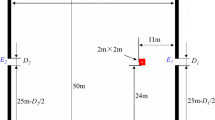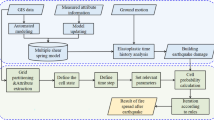Abstract
Metro stations are mostly located below ground, connected to the outside would through limited channels; the environment is relatively closed. In the event of fire and other emergencies, the evacuation of people from the station is relatively difficult, and evacuation safety judgment and evacuation method still need further research. In order to study the influencing factors of passenger evacuation in the event of an emergency at a subway station and improve evacuation efficiency, a subway passenger fire evacuation model was constructed and simulated according to the variable relationship and response model of subway passenger fire stress response. Based on the system dynamics method, the subway passenger fire stress response model was constructed to simulate the stress response process. This study shows that after 2 min, with the increase of the proportion of passengers responding to problems, the level of passengers' stress response gradually increased. Evacuation efficiency directly affects evacuation time, and the ability to deal with the problem also directly affects the level of stress response, thereby affecting evacuation efficiency. The research results provide a scientific basis for optimizing emergency evacuation plans and strategies, enhancing passenger safety awareness and emergency capabilities, and ensuring the safe operation of the subway.








Similar content being viewed by others
References
Bryan JL (1999) Human behaviour in fire: the development and maturity of a scholarly study area. Fire Mater 23(6):249–253. https://doi.org/10.1002/(SICI)1099-1018(199911/12)23:6%3c249::AID-FAM696%3e3.0
Chen G, Jing J, Geng J (2012) Application research overview of system dynamics. Control Eng China 19(6):921–928. https://doi.org/10.14107/j.cnki.kzgc.2012.06.001
Du C, Zhou X, Zhi L (2014) Simulation and analysis on intersection capacity based on system dynamics. J Univ Shanghai Sci Technol 36(5):449–455. https://doi.org/10.13255/j.cnki.jusst.2014.05.008
Jin T (2014) The physics and simulation of occupant traffic flow in the case of evacuating public building area. Transp Res Part D: Transp Environ 30:76–85. https://doi.org/10.1016/j.trd.2014.05.009
Li N, Sun M, Liang K (2012) Simulation of factors affecting miners’ deliberate violation behavior based on system dynamics. China Saf Sci J 22(5):24–30. https://doi.org/10.16265/j.cnki.issn1003-3033.2012.05.013
Lin X, Song S, Zhai H, Yuan P, Chen M (2020a) Using catastrophe theory to analyze subway fire accidents. Int J Syst Assur Eng Manag 11(1):223–235. https://doi.org/10.1007/s13198-019-00942-2
Lin X, Song S, Yu P, Yuan P (2020b) Study on the stress response of young passengers in different subway passenger densities. Int J Syst Assur Eng Manag 11(6):899–908. https://doi.org/10.1007/s13198-020-01013-7
Lin X, Lin B, Song S, Yu X, Shen F (2021) Model construction and analysis of fire stress response process of subway passengers. China Saf Sci J 31(3):142–147. https://doi.org/10.16265/j.cnki.issn1003-3033.2021.03.020
Lo S, Zhao C, Liu M, Coping A (2008) A simulation model for studying the implementation of performance-based fire safety design in buildings. Autom Constr 17(7):852–863. https://doi.org/10.1016/j.autcon.2008.02.014
Ministry of Housing and Urban-Rural Development of the People's Republic of China (2014) Code for design of metro(GB 50157-2013), China Architecture & Building Press.
Powell J, Mustafee N, Chen A, Hammond M (2016) System-focused risk identification and assessment for disaster preparedness: dynamic threat analysis. Eur J Oper Res 254(2):550–564. https://doi.org/10.1016/j.ejor.2016.04.037
Shao C, Zhang Y, Zhang J, Bai F (2005) Qualitative prediction on group evacuation via feedback analysis. J Syst Simul 4:978–981. https://doi.org/10.3969/j.issn.1004-731X.2005.04.061
Shobeir K, Ezatollah K, Laurie B, Robin D (2017) System dynamic simulation: a new method in social impact assessment (SIA). Environ Impact Assess Rev 62:25–34. https://doi.org/10.1016/j.eiar.2016.07.009
Song X, Ma L, Ma Y, Yang C, Ji H (2016) Selfishness- and selflessness-based models of pedestrian room evacuation. Phys A 447:455–466. https://doi.org/10.1016/j.physa.2015.12.041
Xiao G, Wang P, Chen B (2004) Dynamic model of human behavior in building fire evacuation. Syst Eng Theory Pract 24(5):134–139. https://doi.org/10.1007/BF02911033
Xiao G, Wen L, Chen B (2020) Review and perspective in the study of human behavior during evacuation from building fire. China Saf Sci J 11(1):223–235. https://doi.org/10.16265/j.cnki.issn1003-3033.2001.03.009
Xu W, Liu Z (2012) The study of individual safety experiences based on system dynamics. Ind Saf Environ Prot 38(8):90–93. https://doi.org/10.3969/j.issn.1001-425X.2012.08.029
Xu Z, Volker C (2012) Combining system dynamics model, GIS and 3D visualization in sustainability assessment of urban residential development. Build Environ 47:272–287. https://doi.org/10.1016/j.buildenv.2011.07.012
Yan W, Wang J, Jiang J (2016) Subway fire cause analysis model based on system dynamics: a preliminary model framework. Proced Eng 135:431–438. https://doi.org/10.1016/j.proeng.2016.01.152
Yang L (2009) Emergency evacuation system and simulation in public. Central South University, Changsha
Yang Q, Li Y, Sun D, Lee T (2016) The effects of stress on risky and social decision making. Adv Psychol Sci 24(6):974–984. https://doi.org/10.3724/SP.J.1042.2016.00974
Zhang Z, Chen J, Yang L (2008) Calculation of personnel safety evacuation time in subway fire accidents. Modern Urban Rail Transit 3:68–70. https://doi.org/10.3969/j.issn.1672-7533.2008.03.026
Funding
This work is supported by Start-up Funds for Post-doctoral Researches of Ma’anshan University, Grant No. PRC2021001; Anhui Province Housing and Urban Rural Construction Science and Technology Plan Project, Grant No. 2022-YF005; Funding Project for Scientific Research Activities of Postdoctoral Researchers in Anhui Province, Grant No. 2022B633; and Natural Science Research Project of Anhui Educational Committee, Grant No. 2023AH051123.
Author information
Authors and Affiliations
Corresponding author
Ethics declarations
Competing interests
The authors declare that they have no conflict of interest or competing interests.
Ethical approval
The manuscript has not been submitted to more than one journal for simultaneous consideration. The manuscript has not been published previously. The Research not involved human participants and/or animals.
Additional information
Publisher's Note
Springer Nature remains neutral with regard to jurisdictional claims in published maps and institutional affiliations.
Rights and permissions
Springer Nature or its licensor (e.g. a society or other partner) holds exclusive rights to this article under a publishing agreement with the author(s) or other rightsholder(s); author self-archiving of the accepted manuscript version of this article is solely governed by the terms of such publishing agreement and applicable law.
About this article
Cite this article
Lin, X., Chen, S., Ji, B. et al. Research on a subway fire evacuation model based on system dynamics. Int J Syst Assur Eng Manag 15, 5196–5205 (2024). https://doi.org/10.1007/s13198-024-02513-6
Received:
Revised:
Accepted:
Published:
Issue Date:
DOI: https://doi.org/10.1007/s13198-024-02513-6




